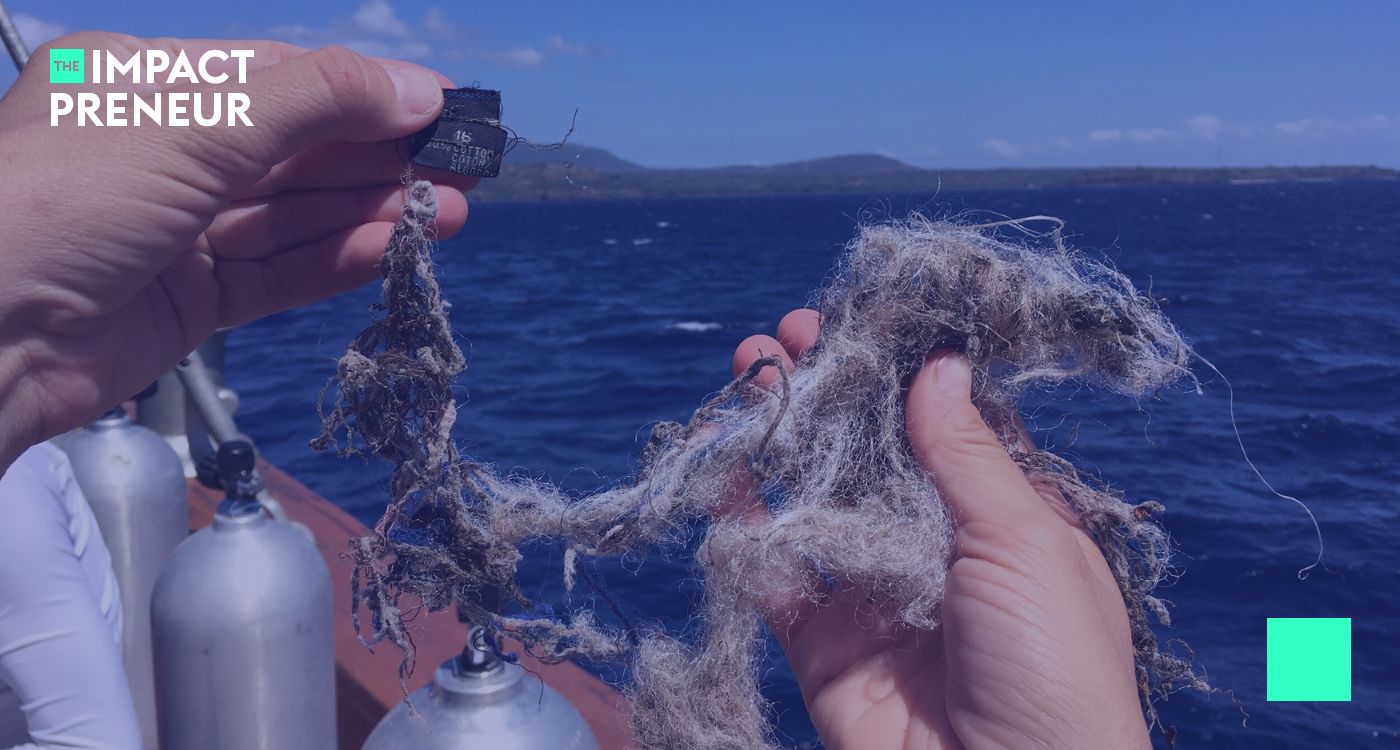Photo: Micro Fibers in the Ocean | Source: Materevolve - Website
Have you ever paused while folding laundry and wondered where all those clothes will end up? No? Well, let’s change that today. Let’s dive into the fascinating world of sustainable textiles, a realm where fashion meets eco-consciousness head-on. We're not just talking about swapping your synthetic sweater for a cotton one. Oh no, we're venturing into an innovative domain where the threads of our clothes intertwine with the very elements of nature: sea, soil, and circularity. Ready to unravel how your wardrobe can literally change the world?
Quick Bites:
- Sustainable textiles are more than a trend, it's a necessity for the planet's future.
- Innovative materials and practices are combating the silent but deadly issue of microfiber pollution.
- Regenerative agriculture is weaving environmental stewardship into the very fabric of our clothes.
- The fashion industry is closing the loop, ensuring clothes are designed to have a life beyond the wardrobe.
The Fabric of Our Lives: Beyond Cotton and Polyester
Once upon a time, in a world not so different from ours, fashion was a cyclic affair. Fast forward to today, and the scenario has dramatically shifted. We're now churning out clothes faster than we can wear them, leading to a monumental waste problem. Enter Krystle Moody Wood, a visionary in the sustainable textiles sphere, who’s weaving a new narrative for the fashion industry. But what exactly is this narrative, and why should we care?
First off, let’s address the elephant in the room: the fashion industry’s environmental footprint. It's huge. Like, really huge. We're talking about mountains of clothes ending up in landfills, rivers of dye polluting our waters, and enough carbon emissions to make your head spin. It's about an industry historically marked by waste, pollution, and an insatiable appetite for resources. But picture this: a world where your clothes do more good than harm, where each garment tells a story of sustainability and innovation. This isn't a distant dream but the mission of visionaries like Krystle Moody Wood, founder and principal consultant of Materevolve, a consultancy pioneering the sustainable textiles movement.
Krystle’s journey is nothing short of inspirational. Picture this: a young, passionate student stepping into the world of textile science with dreams of marrying design with sustainability. Fast forward a few years, and she’s at the helm of Materevolve, steering the fashion industry towards a greener future. But how, you ask?
"I was really inspired to work in sustainability, to bring my left brain and my right brain together. And I found this textile science degree," Krystle shares about her journey from a UC Davis student to a leader in sustainable fashion.
What sets Krystle apart is her holistic approach to sustainability. It’s not just about choosing organic cotton over conventional cotton; it’s about reimagining the entire lifecycle of textiles. Through her work, Krystle champions the integration of eco-friendly materials and practices into the fashion industry, ensuring that each step—from cultivation to creation, and eventually, decomposition—is aligned with the principles of sustainability.
The impact of sustainable textiles extends far beyond the environment. It's about fostering a deeper connection between consumers and their clothes, encouraging mindfulness and intentionality in our fashion choices. It's a call to action for consumers, designers, and brands alike to consider the broader implications of their decisions and to work together towards a more sustainable future.
Sea: The New Frontier in Textile Innovation
The ocean, vast and teeming with life, is also a mirror reflecting our consumer habits back at us. Microfiber pollution, largely invisible to the naked eye, is a stark reminder of fashion's toll on marine ecosystems. The clothes we wash and wear shed fibers that journey through waterways and end up in the ocean, contributing to pollution that threatens aquatic life and, by extension, our own health.
"I think more people understand plastic pollution as it relates to the oceans. But fibers are even more ubiquitous and they're not something that we can see," Krystle illuminates the severity of the issue, urging a shift in perspective and practice.
But here's where it gets interesting. What if we could design textiles that the ocean could digest? Imagine wearing a shirt that, at the end of its life, could safely return to the sea, leaving no trace behind. This is not a pipe dream but a reality that Materevolve is working towards. By exploring biodegradable materials and encouraging innovation in textile recycling, they're not just addressing the issue but actively finding solutions.
The vision is both bold and achievable: a fashion industry that not only minimizes its impact on the ocean but actively contributes to its health. It's an ambitious goal, but one within our reach if we embrace innovation and strive for materials that coexist harmoniously with marine ecosystems. The path forward involves research, collaboration, and a willingness to rethink our relationship with the natural world.
Soil: The Unsung Hero of Sustainable Textiles
Now, let’s get our hands dirty and talk about soil. Not the first thing that comes to mind when you think of fashion, right? But here’s a plot twist: soil health is directly linked to the materials we wear. Krystle shares fascinating insights into how regenerative agriculture practices can revolutionize the textile industry. It’s all about going back to the roots (pun intended) and ensuring that the cultivation of natural fibers like cotton and hemp contributes positively to the environment.
But it's not just about growing plants in a sustainable manner. It’s about rethinking our entire approach to material sourcing and production, ensuring that those materials are produced in a way that enriches the soil and the environment. This connection between what we wear and the earth beneath our feet is a powerful reminder of the interdependence of all living systems. The beauty of focusing on soil health is that it offers benefits far beyond the realm of fashion. Healthy soil acts as a carbon sink, helping to mitigate the effects of climate change. It supports biodiversity and enhances ecosystems.
This approach requires a shift in mindset from both producers and consumers. It's about seeing the value in materials that are not only environmentally friendly but also socially and economically beneficial. For farmers, regenerative practices offer a way to improve crop yields and resilience. For brands, it's an opportunity to create products that customers can feel good about wearing, knowing that they contribute to a larger, positive impact on the world.
Materevolve advocates for a close-knit relationship between fashion brands and farmers, ensuring that every thread woven into our clothes is a testament to environmental stewardship. The challenge, of course, is scale. Transitioning to regenerative agriculture and sustainable materials isn't something that can happen overnight. It requires collaboration across industries, significant investment, and a willingness to innovate. But the rewards—sustainable fashion that supports the health of our planet and its inhabitants—are immeasurable.
Circularity: Closing the Loop on Fashion Waste
Circularity in fashion is about more than just recycling old clothes. It's a holistic approach that considers the entire lifecycle of a garment, from design to disposal. In a truly circular fashion industry, nothing goes to waste. Every piece of clothing is designed with its next life in mind, whether that means being repurposed, recycled, or safely composted back into the earth. It’s a vision where every piece of clothing you own could potentially lead infinite lives, reincarnated in various forms and never ending up in a landfill.
Krystle's advocacy for circularity is a call to action for the fashion industry to rethink how clothes are made and used. It's an ambitious vision, but one that's gaining traction as consumers become more aware of the environmental impact of their fashion choices. By embracing circular design principles, brands can reduce waste, conserve resources, and create more sustainable products.
The principles of circularity also challenge us to change our relationship with fashion. It's about valuing quality over quantity, choosing versatile and durable pieces over fast fashion, and considering the end-of-life of our clothes before we even purchase them. This shift in perspective is crucial for moving towards a more sustainable fashion industry.
Taking Action: Your Role in Sustainable Fashion
Now that we've explored the pillars of sustainable textiles—sea, soil, and circularity—you might be wondering how you can contribute to this green revolution. Here are a few steps you can take to make a difference:
- Educate Yourself: Knowledge is power. Dive deeper into the topics of sea, soil, and circularity to understand the impact of your fashion choices.
- Support Sustainable Brands: Look for brands that prioritize sustainability in their materials, production processes, and business practices. Your purchasing power can drive change in the industry.
- Think Twice Before You Buy: Ask yourself if you really need that new item of clothing. Opt for quality over quantity, and consider second-hand shopping to reduce your environmental footprint.
- Reduce, Reuse, Recycle: Can you repurpose or repair items you already own? When you do need to dispose of clothing, look for recycling options rather than throwing them away.
- Care for Your Clothes: Extend the life of your garments through proper care. Washing less frequently, using eco-friendly detergents, and repairing instead of discarding can make a big difference.
- Embrace Circularity: When shopping for new clothes, consider the entire lifecycle of the garment. Choose items that are designed to be durable, versatile, and recyclable or compostable at the end of their life.
- Advocate for Change: Use your voice to promote sustainability in fashion. Whether it’s through social media, conversations with friends, or supporting environmental causes, every action counts.
Sustainable textiles represent a hopeful future for fashion—one where our clothes not only reflect our style but also our commitment to the planet. By embracing the principles of sea, soil, and circularity, we can all play a part in shaping this future. Change starts with awareness, grows with action, and blossoms with collective effort.
Questions on the Topic
Q: What are the major challenges and solutions in the textile industry regarding sustainability?
A: The biggest drop? Overconsumption. We're producing more clothes than the planet can handle, leading to a fashion flood. But wait, there's a twist. Innovative brands are pioneering the way to close the loop, crafting quality over quantity and turning yesterday's threads into tomorrow's treasures. And the secret sauce? A hearty blend of natural fibers, sustainable practices, and a sprinkle of circularity.
Q: How does Krystle Moody Wood approach a new project with a brand looking to become more sustainable?
A: She starts by digging into the brand's material strategy and sustainability goals, searching for the hidden links and missed connections. It's like detective work but for eco-friendliness. From there, it's all about crafting a tailor-made plan that aligns with the brand's ethos, whether that's diving into the deep end with green chemistry or weaving the magic of regenerative agriculture into their products.
Q: What's the deal with materials? Which ones are getting the thumbs up, and which are being shown the door?
A: In the world of textiles, not all materials are created equal. Krystle's casting a spotlight on the naturals—cotton, hemp, linen, and wool—giving them a standing ovation for their environmental performance. But it's not just about picking the greenest of the bunch; it's about diving deep into how these materials are grown, harvested, and woven into the fabric of our lives. On the flip side, synthetic fibers like polyester are getting a bit of a cold shoulder, thanks to their not-so-eco-friendly rap sheet.
Q: How can we, as consumers, make more sustainable fashion choices?
A: Ready for a secret? You've got more power in your wallet than you think. Krystle's advice is to pause and ponder before you purchase. Does this piece truly reflect your style and values? Is it something that will stand the test of time, both in durability and design? By choosing brands that align with your eco-conscious ethos and opting for materials that play nice with the planet, you're casting a vote for the kind of world you want to live in. And remember, sometimes the most sustainable option is already hanging in your closet.




